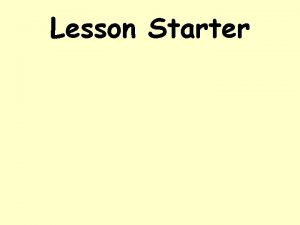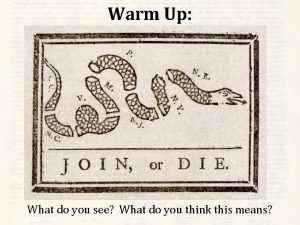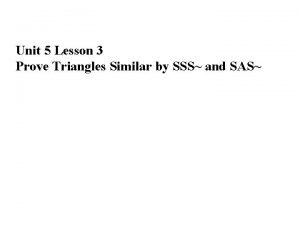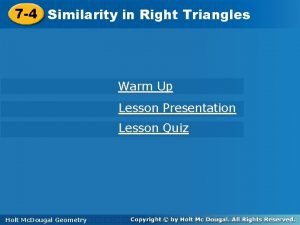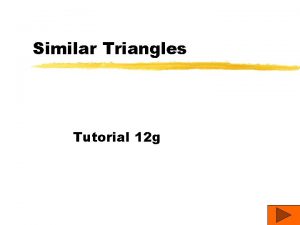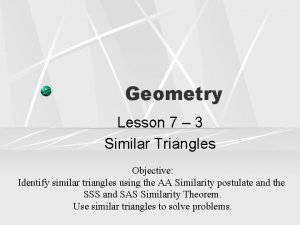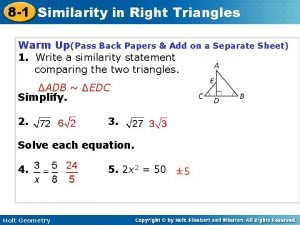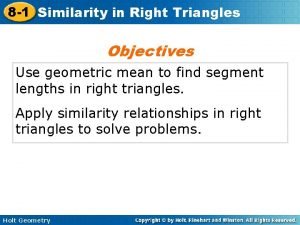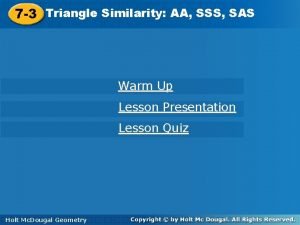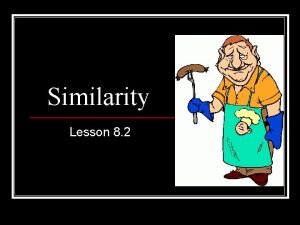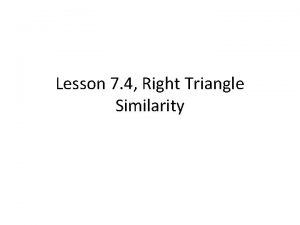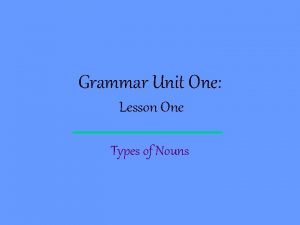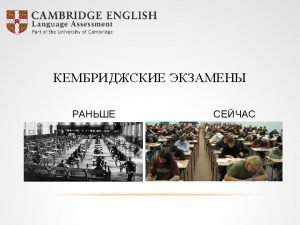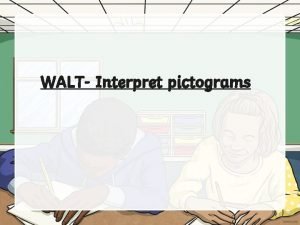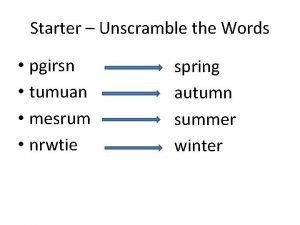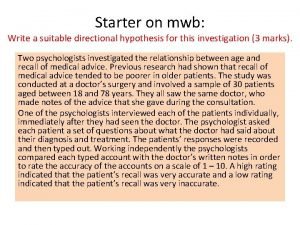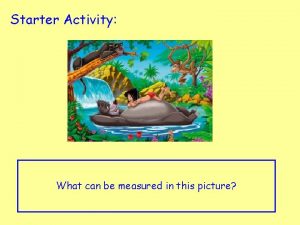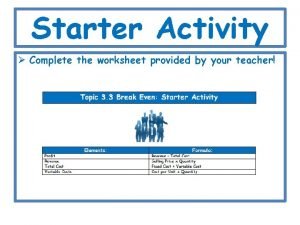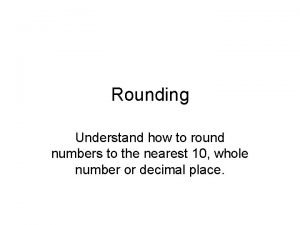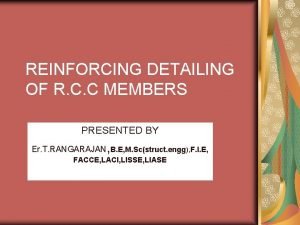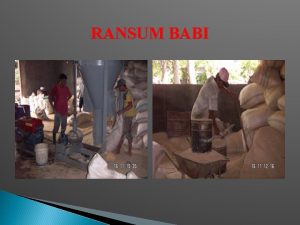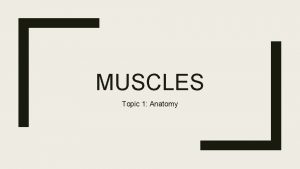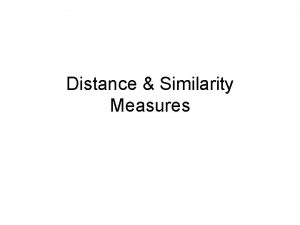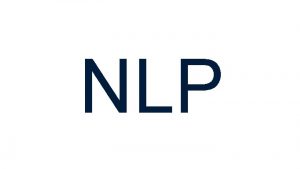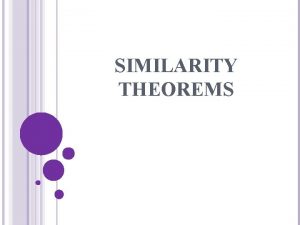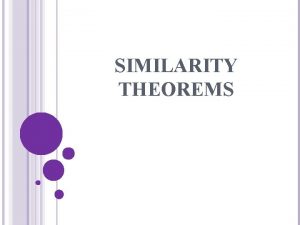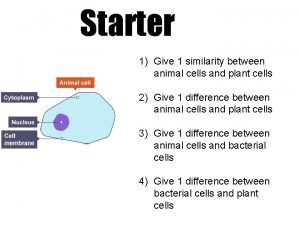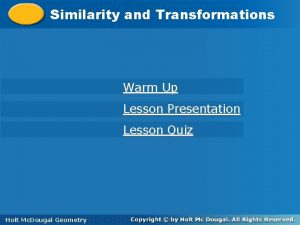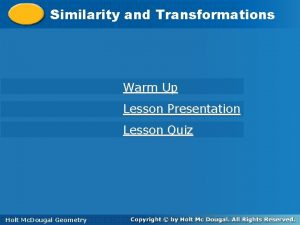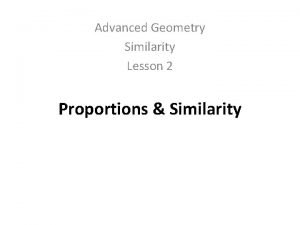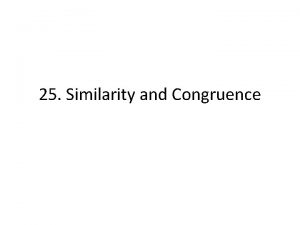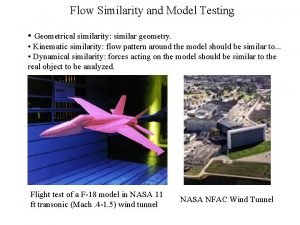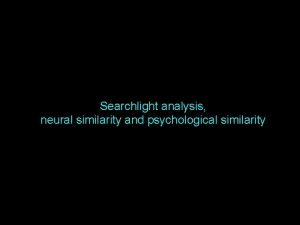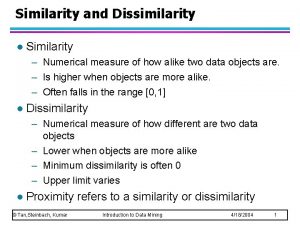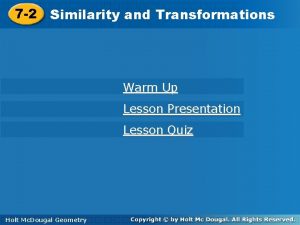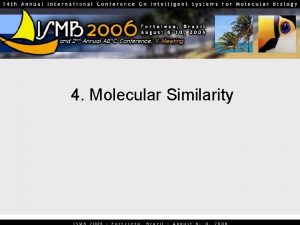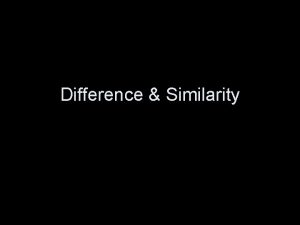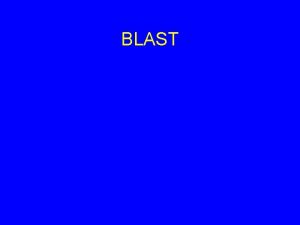Lesson starter 1 Give one similarity and one































- Slides: 31

Lesson starter 1. Give one similarity and one difference between diffusion and osmosis 2. Explain why water is described as a polar molecule.

Answers 1. Both are involved in movement from an area of high concentration to an area of low concentration / are passive / do not require ATP Osmosis refers to water molecules only, but diffusion refers to many different molecules and ions. 2. It has different areas of positive and negative charges.

Title: Communication between cells December 2021 Learning question: How do cells communicate? Homework: Homework due Wednesday 15 th October LP 9

Key words • • • Pathogens Cell signalling Cytokines Receptor Antigen Complementary Lymphocyte Chemotaxis cell Antigen-presenting

Aims from specification (i) outline the mode of action of antibodies, with reference to the neutralisation and agglutination of pathogens; (j) describe the structure and mode of action of T lymphocytes and B lymphocytes, including the significance of cell signalling and the role of memory cells;

Task 1 - Measuring blood glucose concentrations • Read the section “Cell Signalling” on page 170 • Summarise what cell signalling is • Tell the person next to you what you have summarised • Write down key words that you think are important

Cell signalling • “foreign” proteins are recognised by cell – coordinated response initiated so cells can work together, effectively • Chemicals called cytokines released and detected by other cells that bring about the immune response • Some cells in the body have surface receptor proteins that are complementary to foreign antigens • Once detected, lymphocyte is activated

What sort of information is communicated? • • Identification Sending distress signals Antigen presentation Instructions

Identification • Pathogens initiate the signalling (a bit silly) • Antigens on cell surface act as flags to your own body’s cells, telling them that they are foreign / not part of you • Signals are detected by body cells…

Sending distress signals • Pathogens can be damaged by lysosomes to try and fight invader • Results in pathogen damage and parts of pathogen end attached to PM • Results in: – Distress signals sent out which are detected by the immune system – Act as markers to indicate damage to host cell – Killer T cells recognise infection and destroy infected cell

Antigen Presentation • Lymph nodes may start to swell – accumulation of macrophages • Macrophages are phagocytes – they partially digest foreign cells • Antigens are separated out from the partially digested mix of pathogen and the macrophage presents these on its own cell surface • Macrophage becomes an antigen presenting cell • Macrophage goes off to find lymphocytes that can neutralise that particular antigen


Instructions • Cytokines – chemical signals that act as instructions to their target cells • Cytokines travel over short distances and in low concentration • They act by binding to specific membranebound receptors on the target cell • Causes the release of second messengers inside the cell to alter the cell’s gene expression (therefore behaviour)

Instructions • Cytokine communication includes the following: • Macrophages release monokines (chemicals that attract neutrophils) • Monokines stimulate B cells to differentiate and produce antibodies • (Chemotaxis – movement of cells towards a chemical)

Instructions • T and B cells and macrophages release interleukins, which can stimulate proliferation (growth) and differentiation (specificity) of B and T cells • Cells release interferon, inhibits viral replication and stimulates activity of T killer cells

Antigen presenting cell Chemotaxis • Macrophages present fragments of foreign cell protein on cell surface • Macrophages release monokines that attract neutophils. • B cells stimulated to release antibodies Interleukins release • Proliferation and differentiation of B and T cells • Many cells release inferon – inhibit viral replication and stimulate activity of killer T cell

Questions to think about I wonder why cell surface receptors have to be specific I wonder why the immune system does not attack its own cells

Task 2 Have a go at some questions on immunity and see what you’ve learned so far!

Title: The specific immune response December 2021 Learning question: what is a specific immune response and how does it work? Homework: Be fabulous

Key words • • mory Immunological me Clonal selection Plasma cells B cells T helper cells T killer cells T memory cells

Aims from specification (j) describe the structure and mode of action of T lymphocytes and B lymphocytes, including the significance of cell signalling and the role of memory cells;

The Immune Response

The Immune Response • Specific response to the detection of pathogens • Specialised WBCs have receptors on plasma membrane surface • Antibodies produced to fight foreign antigens • Immunological memory – memory cells – long term protection (remain in body for years)

Starting the response • Invading pathogens have foreign antigens – detected by specific B and T lymphocytes in immune response • Receptor molecules (cell surface proteins) are complementary to antigen • Once the correct B/T cell detects the antigens, immune response begins http: //www. nobelprize. org/educational/me dicine/immunity/immune-detail. html

Starting the response • Initial immune response can be slow (few B/T cells to find antigens) • Presentation of foreign antigens increases chance of correct B/T cells finding antigen • Cells that are attacked by pathogen will display pathogenic antigens on cell surface • Macrophages in lymphatic system can become antigen presenting cells – many copies displayed for B/T cells to see

Antigen presenting cell Chemotaxis • Macrophages present fragments of foreign cell protein on cell surface • Macrophages release monokines that attract neutophils. • B cells stimulated to release antibodies Interleukins release • Proliferation and differentiation of B and T cells • Many cells release inferon – inhibit viral replication and stimulate activity of killer T cell

Starting the response • Selecting the correct B and T lymphocytes = clonal selection • Lymphocytes increase their numbers before attacking the foreign antigen – clonal expansion • Division occurs by mitosis! Why not meiosis? ?

T lymphocytes Lymphocytes B lymphocytes

T helper cells Release cytokines – stimulate B cells to stimulate phagocytes T lymphocytes T killer cells Attack and kill infected body cells T memory cells Immunological memory Lymphocytes Plasma cells B lymphocytes Flow in body Manufacture and release antibodies B memory cells Remain in body for several years – immunological memory


Questions to think about I wonder what the difference is between T helper cells and T killer cells. I wonder what the role of memory cells are.
 Lesson starter
Lesson starter What is the main idea of give me liberty or give me death
What is the main idea of give me liberty or give me death Lesson 5 triangle congruence and similarity
Lesson 5 triangle congruence and similarity What is one similarity between ghana and mali
What is one similarity between ghana and mali Unit 5 lesson 3 geometry
Unit 5 lesson 3 geometry 7-4 similarity in right triangles
7-4 similarity in right triangles Lesson 12 modeling using similarity
Lesson 12 modeling using similarity Lesson 7-3 similar triangles answers
Lesson 7-3 similar triangles answers Write a similarity statement comparing the two triangles.
Write a similarity statement comparing the two triangles. Lesson 8-1 similarity in right triangles
Lesson 8-1 similarity in right triangles Sss sas aa
Sss sas aa Definition of similar polygons
Definition of similar polygons Lesson 7-4 similarity in right triangles
Lesson 7-4 similarity in right triangles Romeo and juliet in 10 minutes
Romeo and juliet in 10 minutes Notice writing learning objectives
Notice writing learning objectives Night structure
Night structure Unit one lesson one
Unit one lesson one Unit one lesson
Unit one lesson Starters movers flyers
Starters movers flyers Pictogram starter
Pictogram starter Reichstag fire who was the fire starter
Reichstag fire who was the fire starter Unscramble starter
Unscramble starter Operationalised directional hypothesis
Operationalised directional hypothesis Starter background
Starter background Abiotic factors clipart
Abiotic factors clipart Starter activity
Starter activity Solving equations starter
Solving equations starter Rounding starter
Rounding starter Column starter bars
Column starter bars Formula pakan babi
Formula pakan babi Novellen starter in medias res
Novellen starter in medias res Structure of skeletal muscle
Structure of skeletal muscle
